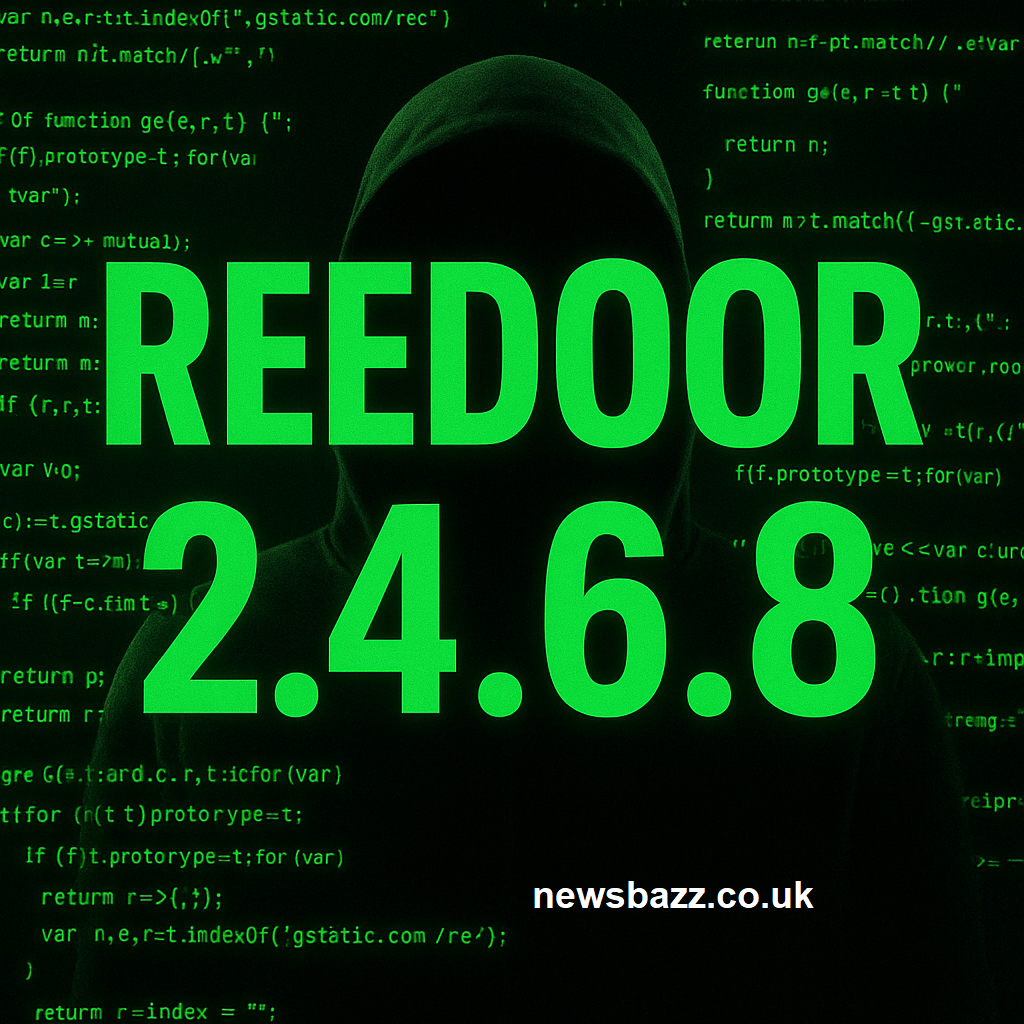Reedoor2.4.6.8: Everything You Need to Know About This Mysterious Term

If you’ve ever come across the term reedoor2.4.6.8 while checking system logs, antivirus notifications, or error reports, you probably wondered what it means. Is it a type of software? A code version? Or maybe a virus?
In this article, we’ll break down everything there is to know about reedoor2.4.6.8 — what it represents, where it appears, why it sometimes causes errors, and how to handle it like a pro. The explanation will be easy to follow yet detailed enough to satisfy tech-savvy readers.
What Exactly Is Reedoor2.4.6.8?
A Versioned Component or Module
The term reedoor2.4.6.8 looks like a software component name with a version tag. The structure — “reedoor” followed by a number pattern “2.4.6.8” — suggests a file or module that has gone through multiple updates. This type of naming is typical for internal tools, plugins, or background system libraries.
While it isn’t officially documented as a widely known program or software, many users have reported seeing this name appear inside update reports, security scans, or technical logs. That means it could belong to a hidden or background process that performs system-related tasks.
Possible Use Cases
In most scenarios, reedoor2.4.6.8 might refer to:
- A background service used by operating systems or third-party software.
- A data handler or process manager.
- A versioned utility used for system maintenance or compatibility.
Because of the numbers, it likely represents the fourth or fifth iteration of an existing module — meaning it has evolved with updates or patches over time.
Why It Draws Attention
People often get curious (or concerned) about reedoor2.4.6.8 because it sometimes triggers antivirus or system alerts. Its unfamiliar name makes users suspicious, especially when it behaves like a system file but isn’t officially documented. That’s why understanding its behavior is so important before taking action.
Common Problems Linked to Reedoor2.4.6.8

Even though reedoor2.4.6.8 is not confirmed as malware, it can still cause a range of small but frustrating problems in computers or devices.
1. Data or Module Errors
One of the most frequent issues associated with reedoor2.4.6.8 is a data error message. This typically occurs when the module fails to load properly or when its files are corrupted. You might see messages like:
- “Reedoor2.4.6.8 failed to initialize.”
- “Module reedoor2.4.6.8 not found.”
- “Data mismatch: reedoor2.4.6.8 process halted.”
These errors usually point to file corruption, missing dependencies, or improper installation of related software.
2. Antivirus Conflicts
Another common scenario involves antivirus programs detecting reedoor2.4.6.8 as a “potentially harmful” or “unknown” file. This may not mean it’s dangerous — just that the antivirus software doesn’t recognize it in its database.
When this happens, users may notice:
- The file being quarantined or deleted.
- Programs that depend on it stop working.
- Repeated warnings every time the system boots up.
It’s important to verify whether it’s a false alarm or a real issue before removing the file.
3. Persistent Reappearance
A particularly confusing symptom is when reedoor2.4.6.8 keeps coming back even after deletion. This could mean that another program reinstalls it automatically during system updates. In such cases, manually deleting the file might not solve the problem — you’ll need to find out which application it belongs to first.
Is Reedoor2.4.6.8 Dangerous or Safe?
There’s no official evidence showing that reedoor2.4.6.8 is harmful. However, because it’s not well-documented, it’s always smart to be cautious.
Reasons It Might Be Legitimate
- The Structured Version Number
The version format “2.4.6.8” looks professional and systematic. Most malware doesn’t use such consistent naming; this hints at a genuine software component. - Tied to System or Software Updates
Many users notice it appearing after updating an operating system or major application. That supports the theory that it’s part of an update process rather than an infection. - Performance Dependence
Some systems stop certain functions after reedoor2.4.6.8 is removed, suggesting it might actually be needed for stability.
Reasons to Be Careful
- Unrecognized by Antivirus Databases
The lack of official recognition means it could be risky if downloaded from unofficial or suspicious sources. - Random Installation Location
If it appears in unusual folders (like Downloads or Temp instead of System folders), that’s a warning sign. - Unclear Purpose
Since there’s no public documentation explaining what reedoor2.4.6.8 really does, treating it carefully is wise.
Balanced Verdict
In short: reedoor2.4.6.8 is most likely a legitimate but poorly documented software component, not an outright virus. Still, treat it cautiously, verify its source, and make backups before making any major changes.
How to Handle Reedoor2.4.6.8 Safely
If your device is showing messages or alerts about reedoor2.4.6.8, don’t panic. Follow these simple steps to check what’s going on and fix any potential problems.
Step 1: Gather Information
- Check your system logs or antivirus reports to see exactly when and where reedoor2.4.6.8 appears.
- Look at its file location. If it’s in a trusted system folder, that’s usually a good sign.
- Note the exact message or error code for reference.
Step 2: Scan the File
Run a complete antivirus and anti-malware scan using trusted software like Windows Defender, Bitdefender, or Kaspersky.
If it’s flagged as a threat, quarantine it temporarily — but don’t delete it right away. Sometimes, removing essential components can cause programs to malfunction.
Step 3: Check File Details
Right-click the file and open Properties (on Windows) or Get Info (on Mac).
Check for:
- Publisher or developer name.
- File creation date.
- Digital signature.
If the signature belongs to a trusted company or OS vendor, it’s likely safe.
Step 4: Update Your System
Outdated systems or software can sometimes misread legitimate files as threats. Make sure your operating system, antivirus, and drivers are up to date. This often resolves reedoor2.4.6.8-related alerts automatically.
Step 5: Consult the Source Application
If you notice that reedoor2.4.6.8 is tied to a specific app, reinstall or repair that program. Many users report that reinstalling the parent software removes the issue entirely.
How to Prevent Future Problems
Once you’ve dealt with reedoor2.4.6.8, it’s smart to take steps that prevent similar confusion or errors in the future.
Keep Software Updated
Regularly update all your apps and system files. Developers often fix compatibility bugs that cause modules like reedoor2.4.6.8 to behave unpredictably.
Avoid Suspicious Downloads
Never install patches, tools, or “fixers” from unverified sources. Many malware infections start this way, often disguising themselves under harmless-looking names like reedoor2.4.6.8.
Perform Regular Maintenance
Use built-in system utilities to:
- Clean temporary files.
- Check disk health.
- Verify integrity of important system components.
This keeps your computer running smoothly and prevents random file errors.
Backup Before Major Changes
Always create a restore point or backup before deleting or altering unknown system files. This way, if reedoor2.4.6.8 turns out to be something important, you can recover easily.
When to Get Professional Help
If you’re not tech-savvy or the problem keeps returning, it might be best to ask for expert assistance.
Take your device to a professional technician if:
- You repeatedly get errors mentioning reedoor2.4.6.8.
- Your system slows down, crashes, or behaves abnormally.
- Antivirus keeps flagging the file even after cleaning or updating.
An expert can use advanced tools to trace the source, check for hidden processes, and ensure your computer is safe.
The Bigger Picture: Why Files Like Reedoor2.4.6.8 Exist
Even though reedoor2.4.6.8 might sound mysterious, files like this are quite common. Software developers use internal names for different builds, patches, or background modules that aren’t always publicly documented.
For example, system updates often include background scripts that handle encryption, user permissions, or communication between software components. Most users never notice them — unless something goes wrong or an antivirus flag appears.
That’s likely the case with reedoor2.4.6.8: it’s not meant to be interacted with directly, but its visibility in logs makes users curious or concerned.
Final Thoughts: What You Should Remember About Reedoor2.4.6.8
To sum it all up, is best described as a versioned software component that sometimes appears in logs or antivirus alerts. It’s not necessarily dangerous — just misunderstood.
Here’s what to remember:
- Don’t delete it blindly.
- Scan and verify its source first.
- Keep your system and antivirus up to date.
- Always back up before making big changes.
Treating it carefully ensures your computer remains both safe and stable. Whether reedoor2.4.6.8 turns out to be a harmless background process or a quirky leftover file, handling it properly means you stay in control — not your system errors.


